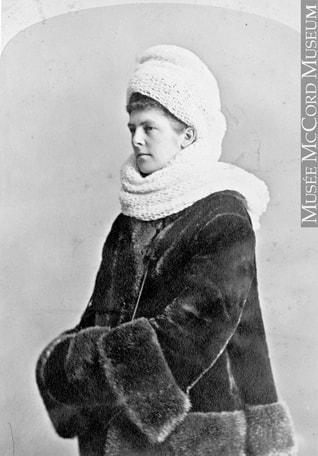 It can get pretty chilly during winter events. One great way to keep warm is to wrap yourself in a cloud. Also known as a Canadian cloud, a nubia, or a nubian, these long scarves were worn throughout much of the 19th century and the early decades of the 20th century. These versatile scarves were either knitted or crocheted and in various weights of yarn, depending on purpose and the station of the wearer. Clouds make frequent appearances in literature of the period, which can give us an idea of their variety and how they were worn. In her autobiography, Clearing in the West, notable Canadian Nellie McClung writes of having a "home-made red and black 'cloud' to wear in the cold weather". Frances Monck, in her book My Canadian Leaves: An Account of a Visit to Canada in 1864-1865, mentions her intention "to get a white cloud" describing it as "a long knitted scarf, which goes all over your cap and round and round your throat, and ties in long ends, and hangs over your back" (189). Agnes Macdonald, the second wife of Sir John A. Macdonald, when writing about what Canadians wear to go for a ride in a "tobogan" for Murray's Magazine, writes of "the fleecy folds of a 'cloud'--that peculiarly Canadian wrap which, consisting of a fringed strip of loosely knitted or woven thick soft wool nine feet long and eighteen inches wide, is both comfortable and becoming" (84). Macdonald gives very specific directions for wearing the cloud: "To arrange properly must be passed over the forehead, leaving one end half as long again as the other; both ends are then crossed behind the neck and drawn forward. The longest end passed once or twice about the neck--letting it lie snugly about ears, throat, cheeks, and chin--is next brought to meet the shorter one, when both are looped together, and the fringed ends fall over the shoulder." (84) The above picture from the McCord Museum shows Lady Dufferin wearing what is presumably a cloud in a manner similar to that described by Macdonald. The cloud was clearly a practical, as well as stylish, garment. The lengths of wool wrapped around one's head and neck would provide good insulation from the cold and keep out the biting winds. Anyone who has experienced a Manitoban winter can appreciate the benefits that would accrue from having a scarf like a cloud. I hope that this introduction to the Canadian cloud has peaked your interest. Next up will be information on how clouds were made in the period and some tips for making your own so that you can bundle up like a true 19th century Canadian. Respectfully yours, Sabrina Note: With the exception of Clearing in the West and where links are provided, all cited sources can be found by searching Google Books.
6 Comments
3/20/2020 09:43:34 pm
I want to keep myself warm for the mean time. My life has not been that great, and I just want some change. I have something that I want to do, but I have no idea how to execute it. I do wish that something great happens to me, it is my wish. If I can be the person that I want, then that is all that matters to me. Thanks for giving me some warm and kind words, man.
Reply
9/1/2020 07:26:04 am
information valuable and excellent design as share good stuff with good ideas and concepts lots of great information and inspiration both of which I need, thanks to offer such a helpful information here. <a href="https://www.devrycourses.com/product/devry-acct-540-week-1-discussion-latest/" > ACCT 540 WEEK 1 DISCUSSION LATEST </a>
Reply
Jahangeer Tareen
6/1/2021 05:03:35 am
Thanks for sharing this.
Reply
6/1/2021 05:08:53 am
While reading your post, I started to feel a slight cold, I can't stand the cold at all. Whenever the cold starts, I go to Asia so that I can keep myself warm.
Reply
1/6/2022 10:32:08 pm
It is my desire that something wonderful occurs to me. All that counts to me is that I may be the person I want to be. Thank you for your kind and nice remarks, guy.
Reply
11/13/2022 06:19:33 pm
Win miss pressure four leave reason try.
Reply
Leave a Reply. |
AuthorGenevieve Woods Archives
May 2019
Categories |
 RSS Feed
RSS Feed